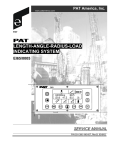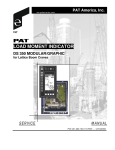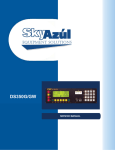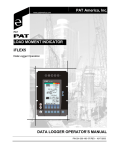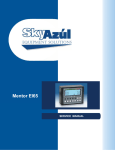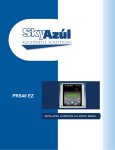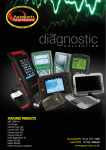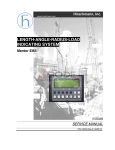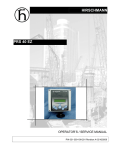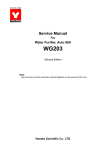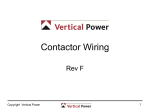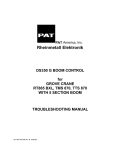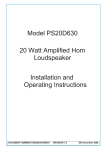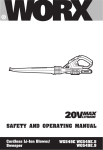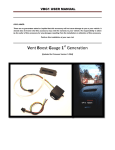Download Hirschmann PAT DS350 RCL Link
Transcript
HIRSCHMANN www.patamerica.com LOAD MOMENT INDICATOR DS350 RCL Link-Belt Construction Equipment LATTICE BOOM CRANES SERVICE MANUAL P/N 031-300-190-038 REV. D 12/05/2005 DS 350 TROUBLESHOOTING HANDBOOK 031-300-190-038 REVISION D 12/05/05 DS 350 TROUBLESHOOTING HANDBOOK NOTICE The information in this document is subject to change without notice. Hirschmann makes no warranty of any kind with regard to this material, including, but not limited to the implied warranties of merchantability and fitness for a particular purpose. Hirschmann shall not be liable for errors contained herein or for incidental or consequential damages in connection with the furnishing, performance or use of this manual. This document contains proprietary information which is protected by copyright. All rights are reserved. No part of this document may be photocopied, reproduced, or translated to another language without prior consent of Hirschmann. DS 350 TROUBLESHOOTING HANDBOOK 031-300-190-038 REVISION D 12/05/05 DS 350 TROUBLESHOOTING HANDBOOK TABLE OF CONTENTS NOTICE GENERAL INFORMATION................................................................................... 1 WARNINGS .......................................................................................................... 1 1.0 ERROR CODE CHART .................................................................................. 2 2.0 SYSTEM COMPONENT LAYOUT.................................................................. 6 3.0 ANGLE SENSOR ADJUSTMENT................................................................... 7 3.1 ANGLE CIRCUIT (WG203) ......................................................................8 3.2 ANGLE CIRCUIT (WG206) ......................................................................9 4.0 LINERIDER SETTINGS AND ADJUSTMENTS ............................................ 10 4.0 General Information................................................................................ 10 4.1 Linerider Zero Point Adjustment ............................................................. 11 4.2 Linerider Output Adjustment................................................................... 12 4.3 Linerider Circuits .................................................................................... 13 4.4 Linerider Cannon Connection ................................................................. 14 5.0 DIGITAL INPUTS.......................................................................................... 15 6.0 ANTI-TWO BLOCK ....................................................................................... 16 7.0 BOOM BASE CABLE REEL DIAGRAM........................................................ 16 8.0 MAIN BOOM / JIB JUNCTION BOX DIAGRAMS ......................................... 17 9.0 LUFFING JIB JUNCTION BOX DIAGRAMS................................................. 18 10.0 SYSTEM ( 12 VOLT ) WIRING DIAGRAM ................................................. 19 10.1 Vertical Console Diagram..................................................................... 20 11.0 SYSTEM ( 24 VOLT ) DIAGRAM................................................................ 21 11.1 Horizontal Console Diagram ................................................................ 22 12.0 TERMINAL BOARD DESIGNATIONS ........................................................ 23 13.0 MAIN BOARD MEASURING POINTS ........................................................ 24 DS 350 TROUBLESHOOTING HANDBOOK 031-300-190-038 REVISION D 12/05/05 DS 350 TROUBLESHOOTING HANDBOOK 1 GENERAL INFORMATION This handbook defines the error codes, cause, and actions to troubleshoot the PAT DS 350 Rated Capacity Limiter (RCL) System for Link-Belt Lattice-Boom Cranes. Refer to the operating handbook for operation and maintenance of the PAT DS 350 Rated Capacity Limiter (RCL). This system assists the crane operator in promoting efficient operation by monitoring crane loads and by warning the operator of approaching overload conditions. Always refer to operational instructions and load charts provided by the crane manufacturer for specific crane operation and load limits. WARNINGS • The operator is always responsible for operating the crane within the manufacture’s specified parameters. • The PAT DS 350 Rated Capacity Limiter (RCL) is an operational aid which warns a crane operator of an approaching overload and over hoist condition which could cause damage to equipment, property, and/or injury to the operator or bystanders. • This device is not, and shall not be a substitute for good judgment, experience, and the practice of accepted safe crane operation. • The operator is solely responsible for the safe operation of the crane and must observe and obey all warnings and instructions supplied by Hirschmann and the crane manufacturer. • Prior to operating a crane, the operator must carefully and thoroughly read and understand the information in operator’s handbook and the crane manufacturer’s manual to ensure that the operator understands the function and limitations of the RCL system and the crane. • Proper operation of the RCL System is dependent upon proper inspection, maintenance, and observance of the operating instructions. DS 350 TROUBLESHOOTING HANDBOOK 031-300-190-038 REVISION D 12/05/05 2 DS 350 TROUBLESHOOTING HANDBOOK 1.0 ERROR CODE CHART ERROR DISPLAY E 01 E 02 E 03 E 04 ERROR Angle luffing jib exceeded. E 07 No acknowledge signal from overload relay. No acknowledge signal from hoist limit switch relay No acknowledge signal from relay 2. Fallen below lower limiting value for the measuring channel “auxiliary force”. E 09 E 13 E 14 E 15 ACTION Fallen below radius or Fallen below the minimum radius or angle range angle given in the load chart due to rising the boom too far. Radius or angle The maximum radius or angle given in range exceeded. the load chart was exceed due to lowering the boom too far. Prohibited slewing Slewing range prohibited with load. range (no load area). Operating mode not Operating mode switch on the available. console set incorrectly. E 06 E 08 CAUSE Fallen below lower limiting value for the measuring channel “force-main hoist”. Fallen below lower limiting value for the measuring channel “angle main boom”. The minimum angle given in the corresponding load chart was exceeded due to lowering the luffing jib too much. Over load limit switch relay is stuck, defective, or not being selected. Put boom back to a radius or angle given in the load chart. Raise boom back to a radius or angle given in the load chart. Slew back into permissible range. Set operating mode switch correctly to the code assigned to the operating mode of the machine. (see Section 9 operator’s handbook) Raise luffing jib to an angle given in the load chart. Replace relay Hoist limit switch relay is stuck, defective, or not being selected. Replace relay Relay 2 is stuck, defective, or not being selected. Cable from central unit to the force transducer defective or water in the plugs. Replace relay Electronic component in the measuring channel defective. Cable from central unit to the force transducer defective or water in the plugs. See Section 3, force transducer adjustments. Check cable and plugs; replace items as necessary. Electronic component in the measuring channel defective. Cable from central unit to the angle sensor defective or loose, or water in the plugs. See Section 3, force transducer adjustments. Check cable and plugs; replace items as necessary. Electronic component the measuring channel defective. See Section 2, angle sensor adjustments. DS 350 TROUBLESHOOTING HANDBOOK Check cable and plugs; replace items as necessary. 031-300-190-038 REVISION D 12/05/05 3 DS 350 TROUBLESHOOTING HANDBOOK 1.1 ERROR CODE CHART - continued ERROR DISPLAY E 16 ERROR CAUSE ACTION Fallen below lower limiting value for the measuring channel “angle luffing jib”. Cable from central unit to the angle sensor defective or loose, or water in the plugs. Check cable and plugs; replace items as necessary. See Section 2, angle sensor adjustments. Replace main board & reset force transducers as shown in Section 3.2. Replace main board & reset force transducers as shown in Section 3.2. Check crane voltage E 18 Error in the reference voltage. Electronic component the measuring channel defective. Electronic component on main board defective. E 19 Error in the reference voltage. Electronic component on main board defective. E 20 No analog voltage. Crane voltage to low E 23 Upper limiting value for the measuring channel “auxiliaryforce” exceeded. Short in supply voltage from crane to central unit. Check wiring Voltage converter is defective on main board Replace main board & reset force transducers as shown in Section 3.2. Check cable and plugs; replace items as necessary. Cable from central unit to the force transducer defective or water in the plugs. Electronic component in the measuring channel defective. E 24 Upper limiting value for the measuring channel “force - main hoist” exceeded. Cable from central unit to the force transducer defective or water in the plugs. Electronic component in the measuring channel defective. E 25 E 26 Upper limiting value for the measuring channel “angle main boom” exceeded. Upper limiting value for the measuring channel “angle luffing jib” exceeded. Cable from central unit to the angle sensor defective or loose, or water in the plugs. Replace main board & reset force transducers as shown in Section 3.2. Check cable and plugs; replace items as necessary. Replace main board & reset force transducers as shown in Section 3.2. Check cable and plugs; replace items as necessary. Electronic component the measuring channel defective. Cable from central unit to the angle sensor defective or loose, or water in the plugs. See Section 2, angle sensor adjustments. Check cable and plugs; replace items as necessary. Electronic component the measuring channel defective. See Section 2, angle sensor adjustments. DS 350 TROUBLESHOOTING HANDBOOK 031-300-190-038 REVISION D 12/05/05 4 DS 350 TROUBLESHOOTING HANDBOOK 1.2 ERROR CODE CHART - continued ERROR DISPLAY E 28 ERROR CAUSE ACTION Error in the reference voltage. Electronic component on main board defective. E 31-34 Error in system software. Eprom’s with system software defective. Replace main board & reset force transducers as shown in Section 3.2. Replace system Eprom E 37 E 38 E 41-42 E 45 E 51-59 Error in system software. Eprom’s with system software defective. Wrong system or data Eprom. Error on the ram. Eprom’s with system software does not correspond with data Eprom. Ram range on the main board defective. Error in internal communications Electronic component on main board defective. Error in read/write memory. Error in data memory. Electronic component on main board defective Data Eprom's defective Electronic component on main board defective. E71 E72 - 77 E89 Incorrect acknowledgment of the 1. Relay on the terminal board a101. analogous to E71 for the relays 2...7. Change of the operating code during lifting a load. Anti two-block relay is stuck or defective. Anti two-block relay is not being selected due to a break on the terminal board a101, main board or ribbon cables. Analogous to e71 for the relays 2...7. The operating mode switch in the console was used during lifting a load. DS 350 TROUBLESHOOTING HANDBOOK Replace main board & reset force transducers as shown in Section 3.2. Replace system Eprom Replace main board & reset force transducers as shown in Section 3.2. Replace system Eprom Replace main board & reset force transducers as shown in Section 3.2. Replace main board & reset force transducers as shown in Section 3.2. Replace data Eprom Replace main board & reset force transducers as shown in Section 3.2. Replace 1. Relay. Check terminal board a101, main board and ribbon cables as well as replace defective part, if necessary. Analogous to E71 for the relays 2..7. Lower the load and set the operating mode switch correctly to the code assigned to the actual operating mode of the crane. 031-300-190-038 REVISION D 12/05/05 5 DS 350 TROUBLESHOOTING HANDBOOK 1.3 ERROR CODE CHART - continued ERROR DISPLAY E 91-92 E 93-94 ERROR CAUSE ACTION No data transmission from console. Plug on console loose; cable defective. Error in the data transmission to the console. Cable to the console not plugged in or interrupted. Check cable and plug; replace console, as necessary. Check cable; attach plug properly. Eprom not installed or defective Replace Eproms Defect in the central electronics (main board). Replace main board & reset force transducers as shown in Section 3.2. E-19/20/29 Error in reference supply voltage. Identify supply voltage that is being shorted, (+/-5 or + -9) disconnect ribbon cable. If power supply returns then problem is external. Reconnect ribbon cables and disconnect all components individually to identify the location of the short. DS 350 TROUBLESHOOTING HANDBOOK 031-300-190-038 REVISION D 12/05/05 DS 350 TROUBLESHOOTING HANDBOOK 6 2.0 SYSTEM COMPONENT LAYOUT DS 350 TROUBLESHOOTING HANDBOOK 031-300-190-038 REVISION D 12/05/05 DS 350 TROUBLESHOOTING HANDBOOK 3.0 ANGLE SENSOR ADJUSTMENT 7 The angle φ shown in Figure 1 needs to be within +0, -0.4 of the actual angle of the boom. Check boom angle at base/heel Section only. After adjustment, compare the actual boom angle with the displayed angle at about 0°, 30° and 60°. To comply with the SAE J375 standards the displayed angle must be +0.0° to -2.0° of the actual angle. WG 203 φ φ Figure 1. Angle Sensor Adjustment. The supply voltage can be checked directly at the cannon connection. Using a digital volt meter measure between pins A and C, (A=GND, C= - 5V). If this voltage is not correct refer to the system wiring diagram and verify all cable connections. You may need to start at the main board and check the supply voltages at their proper measuring points. The following 2 drawings show the theory of operation for the main and luffing angle signals. DS 350 TROUBLESHOOTING HANDBOOK 031-300-190-038 REVISION D 12/05/05 DS 350 TROUBLESHOOTING HANDBOOK 8 3.1 ANGLE SENSOR CIRCUIT (WG203) DRAWING # - LKB24-03 DS 350 TROUBLESHOOTING HANDBOOK 031-300-190-038 REVISION D 12/05/05 DS 350 TROUBLESHOOTING HANDBOOK 9 3.2 ANGLE SENSOR CIRCUIT (WG206) DRAWING # - LKB24-04 DS 350 TROUBLESHOOTING HANDBOOK 031-300-190-038 REVISION D 12/05/05 DS 350 TROUBLESHOOTING HANDBOOK 10 4.0 LINERIDER SETTINGS AND ADJUSTMENTS 4.1 GENERAL INFORMATION Calibration of a linerider will require the hoist rope line pull information, which should be provided by the manufacturer. Use single part line when calibrating the linerider. Lineriders require specific wire rope size, see Table 2 to insure your rope size matches your linerider provided. NOTE: A new wire rope is normally over sized, the amount oversize will depend on the diameter of the rope. With normal wear the inter core breaks down and diameter decreases, See your manufactures guide lines for wire rope replacement conditions. Table 2. Lineriders should match the wire diameter of your hoist rope. ITEM NUMBER DESCRIPTION WITH WIRE ROPE SIZE 048-500-060-005 SENSOR, LINERIDER SKM500 7/8" WIRE ROPE DIAMETER ADVISED RANGE ±3/64 048-500-060-006 SENSOR, LINERIDER SKM500 1" ±3/64 048-500-060-012 SENSOR, LINERIDER SKM500 1-1/8 2 TON KMD ±3/64 048-500-060-013 SENSOR, LINERIDER SKM500 1-1/4 2 TON KMD ±1/16 The linerider requires a load sheave adjustment to maximize the voltage output of the amplifier and minimize the line angle through the linerider. The linerider maximum output of 2.5 volts should be equal to the maximum hoist rope line pull. The load sheave may need to be adjusted by turning the eccentric wheel on the load sheave of the SKM500 linerider, see figure below. L oad Sheave P DS 350 TROUBLESHOOTING HANDBOOK 031-300-190-038 REVISION D 12/05/05 11 DS 350 TROUBLESHOOTING HANDBOOK 4.1 LINERIDER ZERO POINT ADJUSTMENT NOTE: Complete the following processes before placing cable through the linerider. ZERO POINT SETTINGS a.) Check that the differential output of the main and auxiliary linerider is within ±25millivolts at zero force: • Main Linerider: central unit terminal connection X1-#33 and X1-#34. • Auxiliary linerider: central unit terminal connection X1-#23 and X1-#24. b.) Adjust the linerider voltages on the main board, Refer to Figure 2 below. MEMORY X4 MP-13 RAM MP-12 BR-3 DATA EPROM MP-18 MP-1 SYSTEM EPROM MP-19 MP-15 X7 +.500 CPU MP-2 X6 P3 MP-3 P4 MP-4 P5 MP-5 MP-6MP-7 MP-8 MP-9 MP-11 X1 3 X2 2 1 X3 Figure 2. Main Board • • • Adjust the main linerider zero point by placing your positive volt meter lead on MP 3 (measuring point 3) with your ground lead on MP 11. Turn the screw on potentiometer P3 so the volt meter reads a value of 0.500 volts. Adjust the auxiliary linerider by placing your positive volt meter lead on MP 5 with your ground lead on MP 11. Turn the screw on potentiometer P5 so the volt meter reads a value of 0.500 volts. After completing this adjustment run the hoist rope through the lineriders. DS 350 TROUBLESHOOTING HANDBOOK 031-300-190-038 REVISION D 12/05/05 DS 350 TROUBLESHOOTING HANDBOOK 12 4.2 LINERIDER OUTPUT ADJUSTMENT LINERIDER OUTPUT ADJUSTMENTS a) Calculate the output voltage required from the linerider using the known the total load and maximum line pull information. The tolerance for the output voltage “X” is +0.0, -0.2 volts. NOTE: The total load includes the load, rigging, cables, and hook block. Test load should be 80% of maximum rated load for the cranes configuration or condition. To comply with the SAE J376 standards the test load must be to a known accuracy of ±1%. TEST LOAD x 2.5 = ÷ PARTS OF LINE = X LINE PULL 23.600 x 2.5 29.500 = 2.0 ÷ 1 = 2.0 “X” is equal to the to optimum output voltage of the linerider. The output voltage required in this example is 1.8 to 2.0 volts. WARNING: THE OPERATOR IS RESPONSIBLE FOR OPERATING THE CRANE WITHIN THE MANUFACTURE’S SPECIFIED PARAMETERS. b) Pick the test load used in the calculation for the output voltage with a single part of line. c) Take a voltage reading with a voltmeter and compare the reading with the calculated voltage and decide if a mechanical adjustment of the linerider is needed. • • Main Linerider: central unit terminal connection X1-#33 and X1-#34. Auxiliary linerider: central unit terminal connection X1-#23 and X1-#24. d) If a mechanical adjustment is necessary follow steps below, if no mechanical adjustment is necessary proceed to next Section and begin calibration. • • • • Before and after you set the mechanical adjustment, scribe a line on the side of the eccentric wheel to show the amount of change. Loosen the adjustment nut, see Figure 3. Note that there is a single lockout nut on one side and a double on the other. These both should be loosened to some degree. Adjustment from the double nut side seems to work the best after tightening the 2 nuts together. Depending upon the output voltage you can look at the eccentric nut from the side of the linerider and determine the direction you should turn. Increasing the height of the load sheave will increase the output voltage. Tighten all lock nuts insuring not to move the wheel. e) Return and repeat step ‘c’. DS 350 TROUBLESHOOTING HANDBOOK 031-300-190-038 REVISION D 12/05/05 DS 350 TROUBLESHOOTING HANDBOOK 13 4.3 LINERIDER CIRCUIT (MAIN LINERIDER) DRAWING # - LKB24-01 DRAWING # - LKB24-02 DS 350 TROUBLESHOOTING HANDBOOK 031-300-190-038 REVISION D 12/05/05 DS 350 TROUBLESHOOTING HANDBOOK 14 4.4 LINERIDER CANNON CONNECTION LINERIDER CANNON CONNECTION The supply voltage can be checked directly at the cannon connection. Using a digital volt meter measure between pins A and B, (A= + 9v) + (B= - 9v) = 18volts. If this voltage is not correct refer to the system wiring diagram and verify all cable connections. You may need to start at the main board and check the supply voltages at their proper measuring points. DS 350 TROUBLESHOOTING HANDBOOK 031-300-190-038 REVISION D 12/05/05 DS 350 TROUBLESHOOTING HANDBOOK 15 5.0 DIGITAL INPUTS DRAWING # - LKB36-01 DS 350 TROUBLESHOOTING HANDBOOK 031-300-190-038 REVISION D 12/05/05 DS 350 TROUBLESHOOTING HANDBOOK 16 6.0 ANTI-TWO BLOCK CIRCUIT 7.0 BOOM BASE CABLE REEL DIAGRAM DRAWING # - 031-300-100-424 DS 350 TROUBLESHOOTING HANDBOOK 031-300-190-038 REVISION D 12/05/05 DS 350 TROUBLESHOOTING HANDBOOK 17 8.0 MAIN BOOM / JUNCTION BOX DIAGRAMS MAIN BOOM NOSE DRAWING # - 031-300-100-446 JIB NOSE DRAWING # - 031-300-100-522 DS 350 TROUBLESHOOTING HANDBOOK 031-300-190-038 REVISION D 12/05/05 DS 350 TROUBLESHOOTING HANDBOOK 18 9.0 LUFFING ATTACHMENT / JUNCTION BOX DIAGRAMS LUFFING LIMIT BASE DRAWING # - 031-300-100-679 LUFFING JIB NOSE DRAWING # - 031-300-100-535 DS 350 TROUBLESHOOTING HANDBOOK 031-300-190-038 REVISION D 12/05/05 DS 350 TROUBLESHOOTING HANDBOOK 19 10.0 SYSTEM ( 24 VOLT ) DIAGRAM DS 350 TROUBLESHOOTING HANDBOOK 031-300-190-038 REVISION D 12/05/05 DS 350 TROUBLESHOOTING HANDBOOK 20 10.1 VERTICAL CONSOLE DIAGRAM DRAWING # - 031-300-100-502 DS 350 TROUBLESHOOTING HANDBOOK 031-300-190-038 REVISION D 12/05/05 DS 350 TROUBLESHOOTING HANDBOOK 21 11.0 SYSTEM ( 12 VOLT ) DIAGRAM DS 350 TROUBLESHOOTING HANDBOOK 031-300-190-038 REVISION D 12/05/05 DS 350 TROUBLESHOOTING HANDBOOK 22 11.1 HORIZONTAL CONSOLE DIAGRAM DRAWING # - 031-300-100-539 DS 350 TROUBLESHOOTING HANDBOOK 031-300-190-038 REVISION D 12/05/05 DS 350 TROUBLESHOOTING HANDBOOK 23 12.0 TERMINAL BOARD DESIGNATION TERMINAL BOARD DRAWING # - 024-350-060-739 DS 350 TROUBLESHOOTING HANDBOOK 031-300-190-038 REVISION D 12/05/05 DS 350 TROUBLESHOOTING HANDBOOK 24 13.0 MAIN BOARD MEASURING POINTS MEASURING POINT LAYOUT DRAWING # - 024-350-300-081 DS 350 TROUBLESHOOTING HANDBOOK 031-300-190-038 REVISION D 12/05/05





























